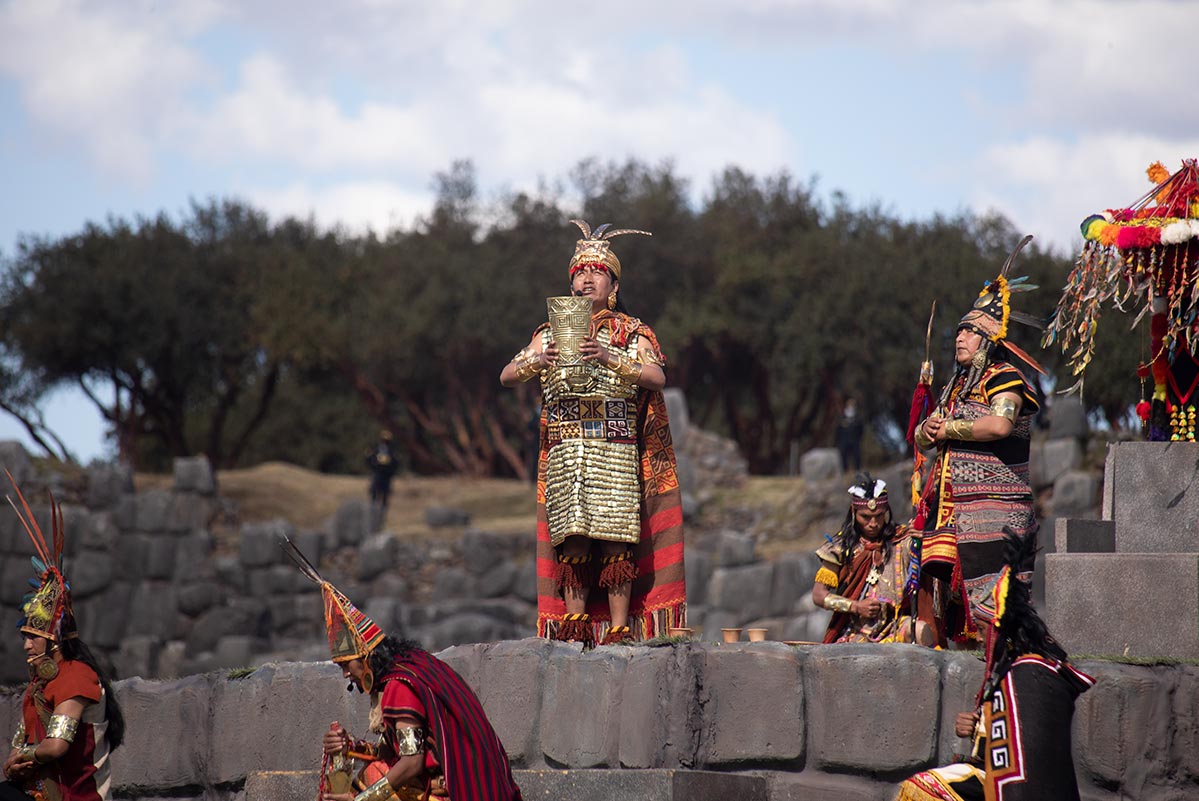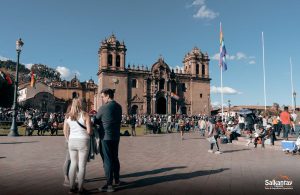If you are visiting Peru in June, one of the things to do in Cusco is to go to the Inti Raymi Festival. You will likely hear about it whenever you visit, to be honest.
What is Inti Raymi?
The Inti Raymi is an ancient celebration that takes place in the Andes of Peru to honor the Sun God or ‘Inti.’ This festival is considered the most important of all Inca festivities as it represents the winter solstice and the gratitude to the sun for the harvest.
‘Inti Raymi’ is a Quechua term that translates to ‘Festival of the Sun’ in Spanish, and it is celebrated in the main square of the city of Cusco since 1412.
The ceremony included the sacrifice of an animal to Pachamama (Mother Earth). After the Spanish invasion, the Inti Raymi and any similar celebrations were banned. However, in 1944, the people of Cusco decided to revive the first representation of this festival, which we can still witness today.
Inti Raymi Festival
It is a theatrical and cultural reenactment that takes place in Cusco and attracts numerous tourists from around the world. The ceremony begins at dawn and lasts throughout the day. Participants dress in traditional Inca costumes and perform rituals and dances in honor of the Sun God.
The event is led by an actor who portrays the role of the Inca, offering prayers and offerings to the sun. Symbolic sacrifices of llamas are also performed, and a large quantity of coca leaves is burned as an offering.
During the celebration, various reenactments representing historical episodes of the Inca Empire take place. These representations include the Inca’s arrival at the Temple of the Sun, the ceremony of gratitude for the harvest, and the worship of the sun.
When is Inti Raymi Celebrated?
On the 24th of June every year, it is celebrated at the archaeological site of Sacsayhuaman. Tourists and locals alike gather to watch the festival take place. It’s an excellent experience to make you feel as though you are being swept back into the time of the Incas and to give you a good idea of what life was like back then.

But why is it so important to the people of Cusco these days? Let’s see.
How is Inti Raymi Celebrated?
Bringing Back Lost Traditions
After discovering Machu Picchu in 1911, people wanted to learn more about this fascinating ancient culture. The construction was so awe-inspiring that they had to know more. Old traditions started being brought back, and the lost city brought them lost traditions.
The Festival of Inti Raymi Peru is one of these lost traditions, and the local people are proud to show off their culture and where they come from.
The ceremony bases as much as possible of what it does on what we have discovered from history books. It honors a new cycle of life just as it used to, and it’s not unusual to see the sky clear right when the Inca raises his hands to the sky.
Cusco is a city that’s full of traditions enjoying many each month. Even so, Inti Raymi in Peru is one of the most important throughout the whole year. Families flock early in the morning to get a good seat with a great site view.
Over 800 actors are used each year and do an excellent job. It’s organized by the university, professional, and neighborhood affiliations. It takes months of practice! You’ll see that the costumes are very well made, and the ceremony lasts the whole day, passing through 2 points in the city before reaching Sacsayhuaman.

What Happens on June 24th?
Temple of Qorikancha
On the day itself, everything begins at Qorikancha, means Temple of the Sun and can be visited during your travel to Cusco, Peru. From here, the Incas worshipped the Sun God, ‘Inti.’
It’s said that when the Spanish first set foot in Cusco, this building was the most spectacular they had seen in all the Americas. Everything was plated in gold, and the garden was full of beautiful flora and fauna, made from gold with a bit of silver.
Imagine seeing this magnificent site with life-sized golden corns and gold-fleeced alpacas on the lawn. It must have been incredible!
As well as all this, Qorikancha was home to many Incan mummies. They were wrapped in divine clothes and set to rest on golden thrones forevermore.
Unfortunately, upon seeing this wonderful building, the Spaniards took all the gold they could find, leaving only the stone construction underneath. This is what we see today.
*If you want to see the start of Inti Raymi Peru from here, you must get there early in the morning.

Plaza de Armas
In the Plaza de Armas Cusco, the ‘Incas’ stop briefly to perform a part of the ceremony. The best way to see this is to get to a balcony on one of the restaurants or cafes surrounding it and watch it all from there.
Sacsayhuaman
They end up in Sacsayhuaman, where the central part of the ceremony takes place. This continues for around 3 hours, full of Incan chants and music. The event takes place in the Quechua language and is an experience you shouldn’t miss!
In the Incan times, these were the most critical places for ceremonies, which is why they are today’s main spots.

Cultural Significance
The Inti Raymi Peru has great cultural significance and is considered one of the most important events in the Andean region. It is a way to keep the tradition and connection with Inca roots alive. Moreover, it allows participants and spectators to experience and appreciate the cultural and spiritual richness of the ancient Inca civilization.
Tips for the Day
To help you enjoy the day to the fullest, we’ve compiled a list of what to do to ensure it goes smoothly.
Book far in advance – The tickets for Inti Raymi can sell out well in advance. Not to mention the hotels, trains, and other tours that all put prices up and sell out quickly. If you plan to come in June, plan far ahead.
Get a ticket inside Sacsayhuaman if you can – Tickets are available to sit right in the middle of the action. If you can get these, do. Otherwise, you can sit on the surrounding hills but won’t get the same experience.
Arrive early – As mentioned, people go very early to ensure they get the best spots. You must be on the ball and do the same to guarantee a great view of the action.
Be careful of those around you – Unfortunately, due to the popularity of the day, pickpockets are also out. Keep things well tucked away in a backpack. Don’t put valuable items in pockets where they can quickly get taken.
What to wear – The Cusco weather can be very unpredictable. However, it tends to be sunny in June and shouldn’t rain. Take a sunhat, sunglasses, and sunscreen, as you will be under the sun. Keep hydrated and take a sweater for when the sun goes in, and it gets a little chilly.

Inti Raymi FAQs
Is it possible to attend the Inti Raymi?
Yes, it is possible to attend Inti Raymi as a spectator. However, keep in mind that it is a very popular event and tickets are usually sold out in advance. We recommend you to book in advance and be prepared for the crowds.
How long does Inti Raymi last?
The main Inti Raymi ceremony lasts approximately 4 hours, from early morning until noon. However, festivities and celebrations related to Inti Raymi may extend throughout the day.
What is the traditional dress during Inti Raymi?
During Inti Raymi, participants wear traditional Inca costumes: colorful ponchos, skirts, hats and leather sandals. The use of decorative elements such as feathers and jewelry is also common.
Can photographs be taken during Inti Raymi?
Yes, it is generally permitted to take photographs during Inti Raymi. However, it is important to respect the instructions of the organizers and not to interfere with the ceremony or disturb other attendees.
Are there any special requirements to attend the Inti Raymi?
There are no special requirements to attend the Inti Raymi. You only need to purchase tickets in advance, wear comfortable and warm clothes, show respect for the ceremony and follow the instructions.

Plan and Enjoy This Spectacular Event
The Inti Raymi has gained popularity among tourists due to its spectacular and cultural authenticity. Every year, thousands of people visit Cusco to witness this unique celebration and immerse themselves in the history and culture of the Incas.
If you are visiting in June and will be here on the 24th, ensure you see this event at any of the 3 locations. It’s well worth it and will be something you’ll never forget. It’s a beautiful way to see how traditions are being kept and to give you a greater insight into the Incas and how they celebrated special events. Enjoy!














Leave A Reply